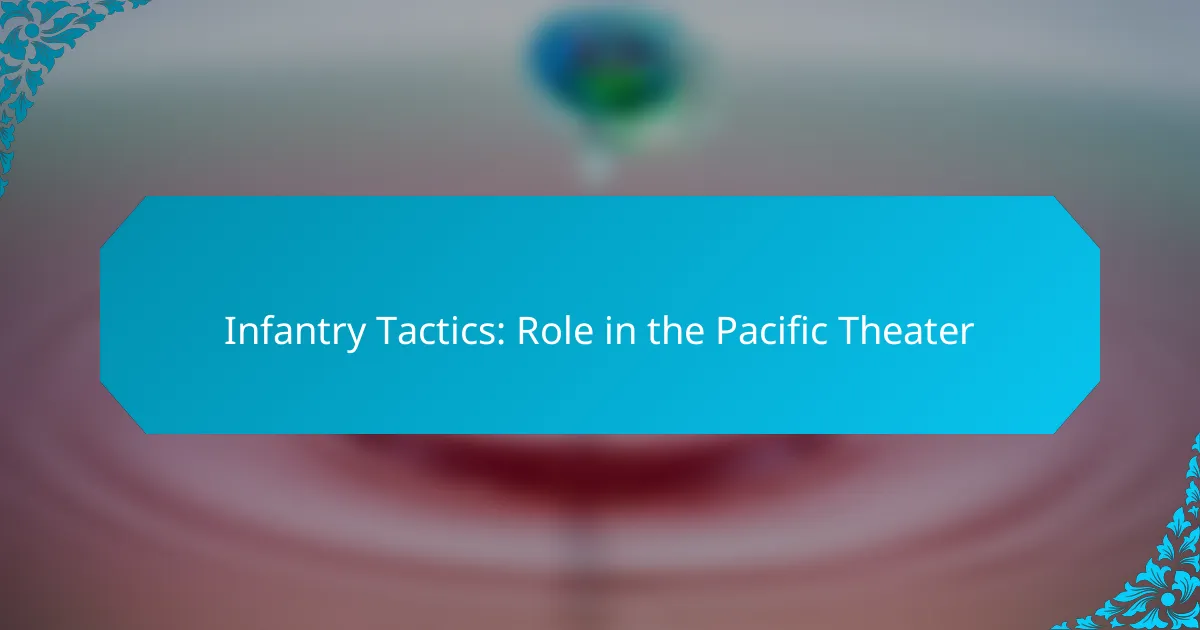Infantry tactics in the Pacific Theater during World War II were characterized by the use of jungle warfare techniques, amphibious assaults, and guerrilla strategies, all tailored to the region’s unique environmental challenges. The diverse terrain, including jungles, beaches, and mountains, required soldiers to adapt their methods for effective movement and combat. Major battles such as Guadalcanal, Iwo Jima, and Okinawa exemplified the critical role of infantry in achieving Allied victory in this complex theater of war.
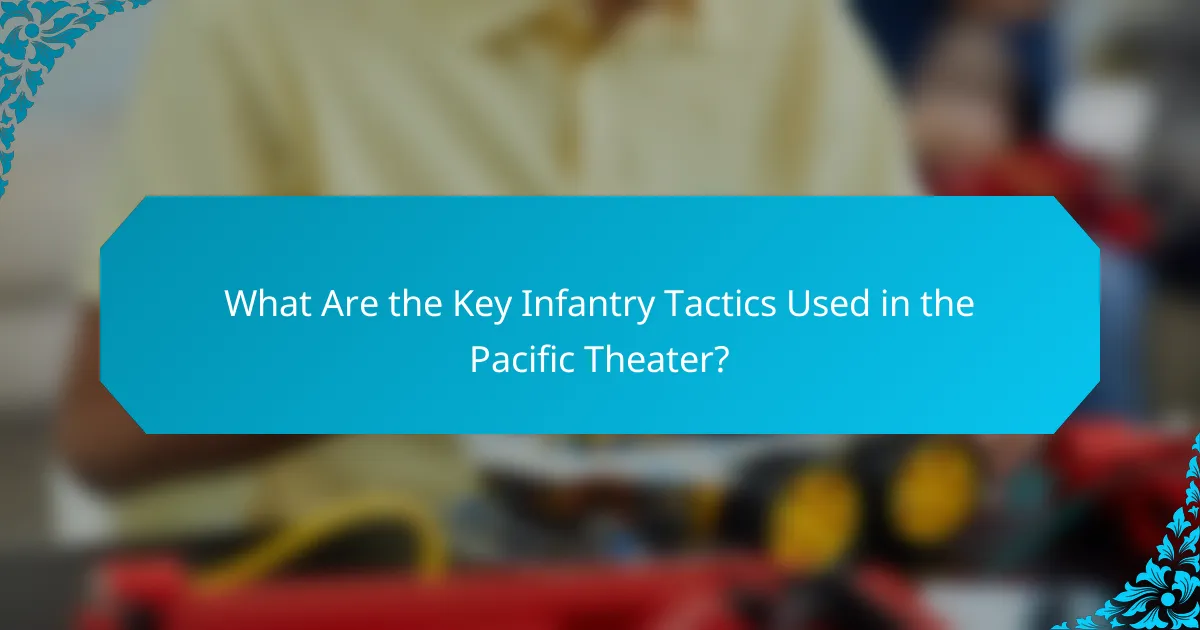
What Are the Key Infantry Tactics Used in the Pacific Theater?
The key infantry tactics employed in the Pacific Theater during World War II included jungle warfare techniques, amphibious assault strategies, guerrilla tactics, and combined arms operations. These methods were essential for overcoming the unique environmental challenges and enemy strategies faced in the region.
Jungle Warfare Techniques
Jungle warfare techniques were crucial for infantry units operating in the dense, tropical environments of the Pacific Islands. Soldiers needed to adapt to limited visibility and difficult terrain, often using stealth and camouflage to avoid detection.
Key strategies included the use of small unit tactics, ambushes, and reconnaissance patrols. Troops were trained to navigate through thick foliage and to employ noise discipline to maintain the element of surprise against enemy forces.
Amphibious Assault Strategies
Amphibious assault strategies were vital for launching attacks from the sea onto enemy-held islands. These operations required precise coordination between naval and ground forces to ensure successful landings.
Common tactics included the use of landing craft to transport troops and equipment, supported by naval gunfire to suppress enemy defenses. Timing and intelligence were critical, as assaults often aimed to exploit weaknesses in enemy positions during low tide or at dawn.
Guerrilla Tactics
Guerrilla tactics played a significant role in the Pacific Theater, especially in areas where conventional forces faced challenges. Local populations often assisted Allied forces by providing intelligence and support for sabotage operations against Japanese supply lines.
These tactics emphasized mobility, surprise, and the use of the environment to the guerrillas’ advantage. Small, agile units could strike quickly and then disappear into the jungle, making it difficult for larger enemy forces to retaliate effectively.
Combined Arms Operations
Combined arms operations integrated different military branches to enhance overall effectiveness in combat. In the Pacific Theater, this meant coordinating infantry, artillery, and air support to achieve tactical objectives.
Effective combined arms operations required clear communication and planning, allowing ground forces to receive air cover and artillery support during engagements. This approach maximized firepower and minimized casualties, making it a preferred tactic in many battles across the Pacific Islands.
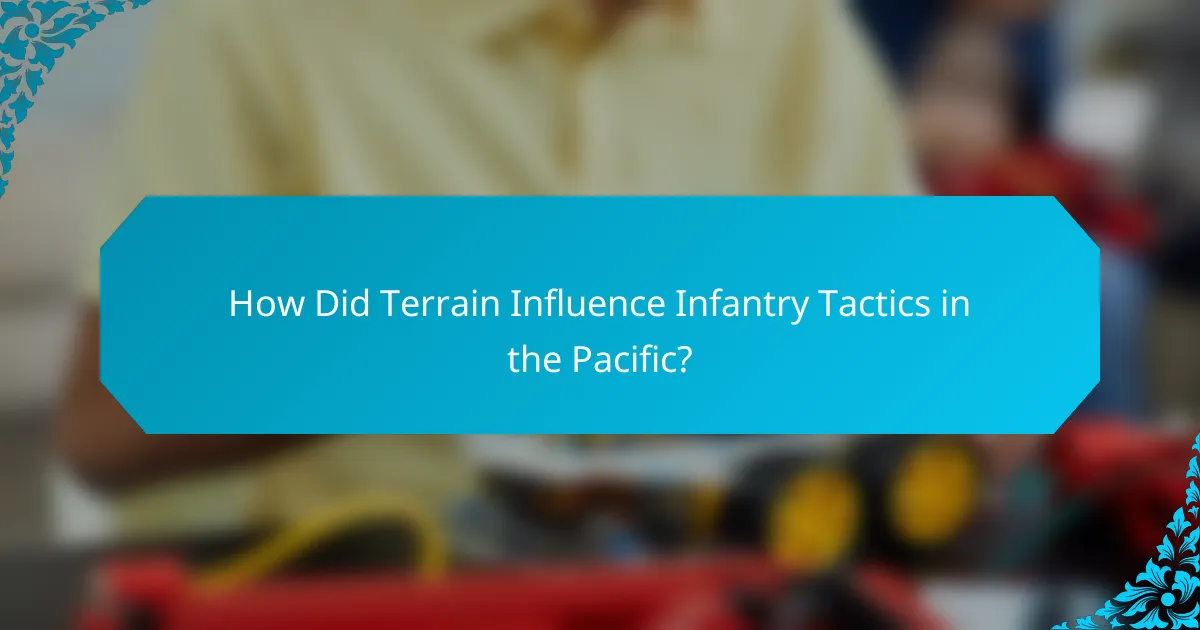
How Did Terrain Influence Infantry Tactics in the Pacific?
The diverse terrain of the Pacific Theater significantly shaped infantry tactics, necessitating adaptations to various environments such as jungles, beaches, and mountainous regions. These adaptations were crucial for effective movement, engagement, and survival in challenging conditions.
Impact of Tropical Climate
The tropical climate of the Pacific islands presented unique challenges for infantry units, including extreme humidity, heavy rainfall, and intense heat. Soldiers had to contend with heat exhaustion and dehydration, which affected their operational effectiveness.
To mitigate these effects, troops often adjusted their schedules to avoid the hottest parts of the day, conducting operations during cooler early mornings or late afternoons. Proper hydration and acclimatization were essential for maintaining combat readiness.
Utilization of Natural Cover
Natural cover, such as dense vegetation and terrain features, played a critical role in infantry tactics. Soldiers used jungles and hills to conceal their movements and positions, making it harder for the enemy to detect and target them.
Effective use of cover allowed infantry units to launch ambushes and surprise attacks, leveraging the element of stealth. Troops were trained to recognize and utilize the landscape to their advantage, often employing guerrilla tactics to disrupt enemy operations.
Challenges of Island Hopping
The strategy of island hopping involved capturing key islands while bypassing others, which presented logistical and tactical challenges. Each island had its own terrain features, requiring tailored approaches for landing and securing positions.
Infantry units faced difficulties such as navigating unfamiliar landscapes and coordinating with naval forces for support. Successful island hopping required meticulous planning, reconnaissance, and adaptability to changing conditions on the ground.
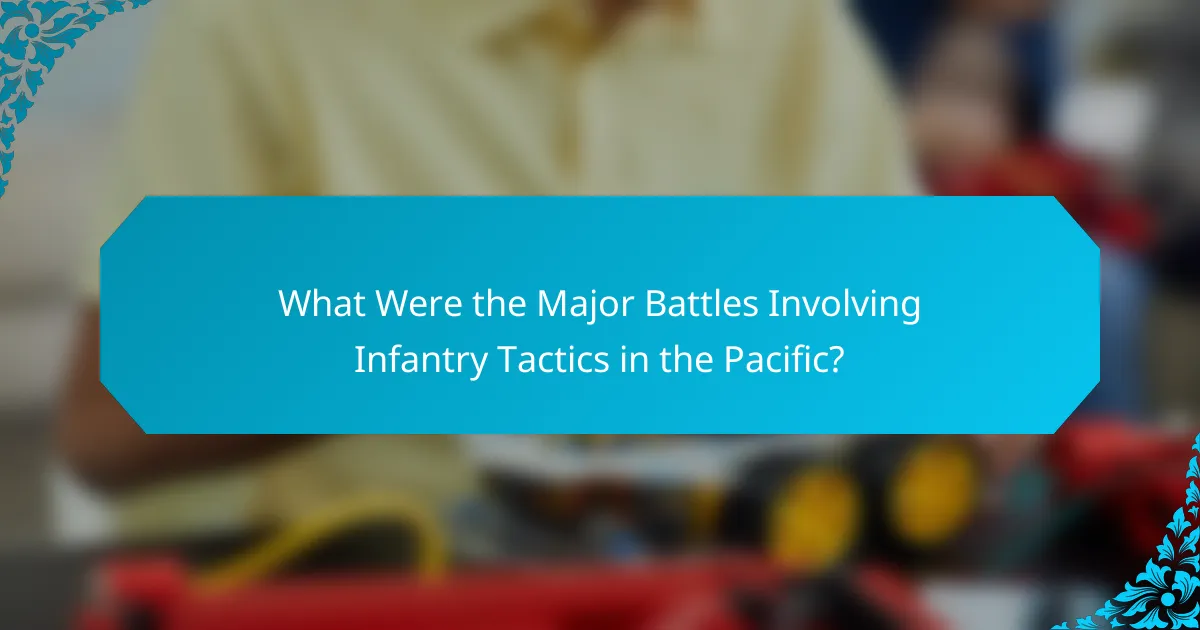
What Were the Major Battles Involving Infantry Tactics in the Pacific?
The major battles involving infantry tactics in the Pacific Theater included Guadalcanal, Iwo Jima, and Okinawa. These engagements highlighted the strategic use of ground forces in challenging environments and played a crucial role in the overall Allied victory in the region.
Battle of Guadalcanal
The Battle of Guadalcanal, fought from August 1942 to February 1943, marked the first major offensive by Allied forces against Japan. Infantry tactics were essential in this jungle warfare, where soldiers faced difficult terrain and harsh conditions.
Key strategies included ambushes, night attacks, and the use of small unit maneuvers to disrupt Japanese supply lines. The successful capture of the island provided a critical base for further operations in the Pacific.
Battle of Iwo Jima
The Battle of Iwo Jima, occurring in February and March 1945, was characterized by intense fighting and significant casualties. U.S. Marines employed infantry tactics such as coordinated assaults and the use of cover to advance against heavily fortified Japanese positions.
The iconic flag-raising on Mount Suribachi symbolized the fierce determination of the Marines. The battle underscored the importance of air support and logistics in supporting ground troops during prolonged engagements.
Battle of Okinawa
Fought from April to June 1945, the Battle of Okinawa was one of the largest amphibious assaults in the Pacific Theater. Infantry tactics focused on seizing key terrain and engaging in close combat with Japanese defenders, who utilized caves and fortified positions.
The battle involved extensive use of combined arms, integrating infantry with artillery and air support. The high casualty rates highlighted the brutal nature of the fighting and the strategic importance of Okinawa as a staging area for a potential invasion of Japan.

How Did Infantry Tactics Evolve During the Pacific Campaign?
Infantry tactics evolved significantly during the Pacific Campaign, adapting to the unique challenges posed by island warfare and the Japanese military’s strategies. Key developments included increased mobility, the use of combined arms operations, and a focus on small-unit tactics to enhance effectiveness in diverse terrains.
Adaptation to Enemy Strategies
Infantry units had to quickly adapt to the guerrilla tactics employed by Japanese forces, which often included ambushes and fortified positions. This led to a shift towards more flexible formations that allowed for rapid response to enemy movements and improved reconnaissance efforts.
For instance, U.S. forces increasingly utilized small, agile units to conduct flanking maneuvers and bypass heavily defended positions. This approach minimized casualties and maximized the element of surprise, proving effective in various battles across the Pacific.
Integration of New Technologies
The Pacific Campaign saw the integration of new technologies that enhanced infantry capabilities, such as improved communication systems and portable weaponry. Radios became essential for coordinating movements and relaying intelligence, allowing units to operate more cohesively.
Additionally, advancements in weaponry, including the M1 Garand rifle and the Browning Automatic Rifle, provided infantry with greater firepower and accuracy. These innovations, combined with the use of air support and naval gunfire, transformed traditional infantry tactics into more dynamic and lethal operations.

What Role Did Leadership Play in Infantry Tactics?
Leadership was crucial in shaping infantry tactics during the Pacific Theater, influencing decision-making, troop morale, and operational effectiveness. Strong commanders adapted strategies to the unique challenges of island warfare, ensuring that units remained cohesive and focused on their objectives.
Influence of Key Commanders
Key commanders like General Douglas MacArthur and Admiral Chester W. Nimitz played pivotal roles in directing infantry tactics. Their leadership styles emphasized flexibility and innovation, allowing units to respond quickly to the fluid battlefield conditions typical of the Pacific. For example, MacArthur’s strategy of “island hopping” prioritized capturing strategically important islands while bypassing heavily fortified ones.
Commanders also fostered a culture of initiative among their officers and soldiers, encouraging them to make tactical decisions based on real-time intelligence. This decentralized approach often led to more effective responses to enemy movements and terrain challenges.
Training and Morale Factors
Effective training programs were essential for preparing infantry units for the harsh realities of combat in the Pacific. Leaders focused on building skills in amphibious operations, jungle warfare, and close-quarters combat, which were critical for success in this theater. Regular drills and realistic simulations helped troops adapt to the unique environmental challenges they faced.
Morale was equally important, as it directly affected combat effectiveness. Leaders implemented various strategies to maintain high morale, including recognition of achievements, support for soldiers’ families, and fostering camaraderie among troops. Units with strong morale were often more resilient and capable of executing complex maneuvers under pressure.
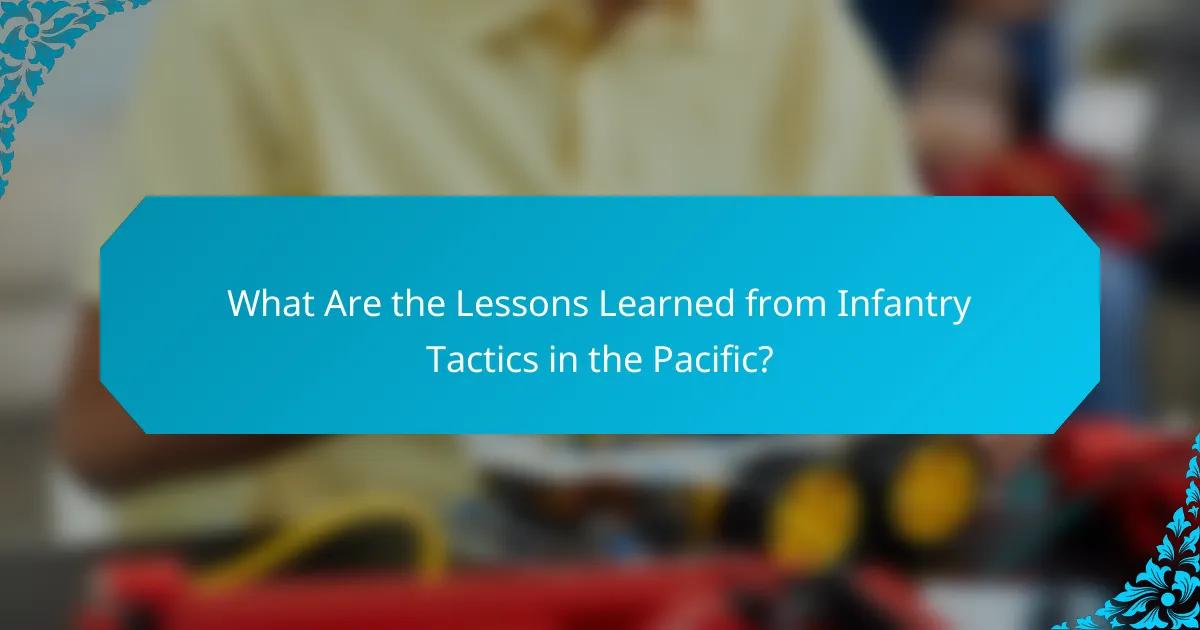
What Are the Lessons Learned from Infantry Tactics in the Pacific?
Infantry tactics in the Pacific Theater emphasized adaptability, intelligence, and the ability to operate in diverse environments. Key lessons include the importance of flexibility in strategy and the critical role of intelligence gathering for successful operations.
Importance of Flexibility
Flexibility in infantry tactics allowed units to respond effectively to the unpredictable conditions of the Pacific Theater. Troops often faced varied terrains, from jungles to islands, requiring rapid adjustments in strategy and deployment.
For example, during the island-hopping campaign, U.S. forces adapted their tactics based on enemy positions and environmental challenges. This adaptability often meant shifting from frontal assaults to more guerrilla-style engagements, maximizing their effectiveness against entrenched Japanese positions.
Significance of Intelligence Gathering
Intelligence gathering was crucial for infantry units to understand enemy movements and plan effective operations. Accurate information about enemy strength, supply lines, and terrain enabled commanders to make informed decisions and reduce casualties.
Methods included aerial reconnaissance, local informants, and intercepted communications. Successful operations, such as the Battle of Midway, demonstrated how superior intelligence could turn the tide in favor of U.S. forces, allowing them to anticipate and counter enemy strategies effectively.
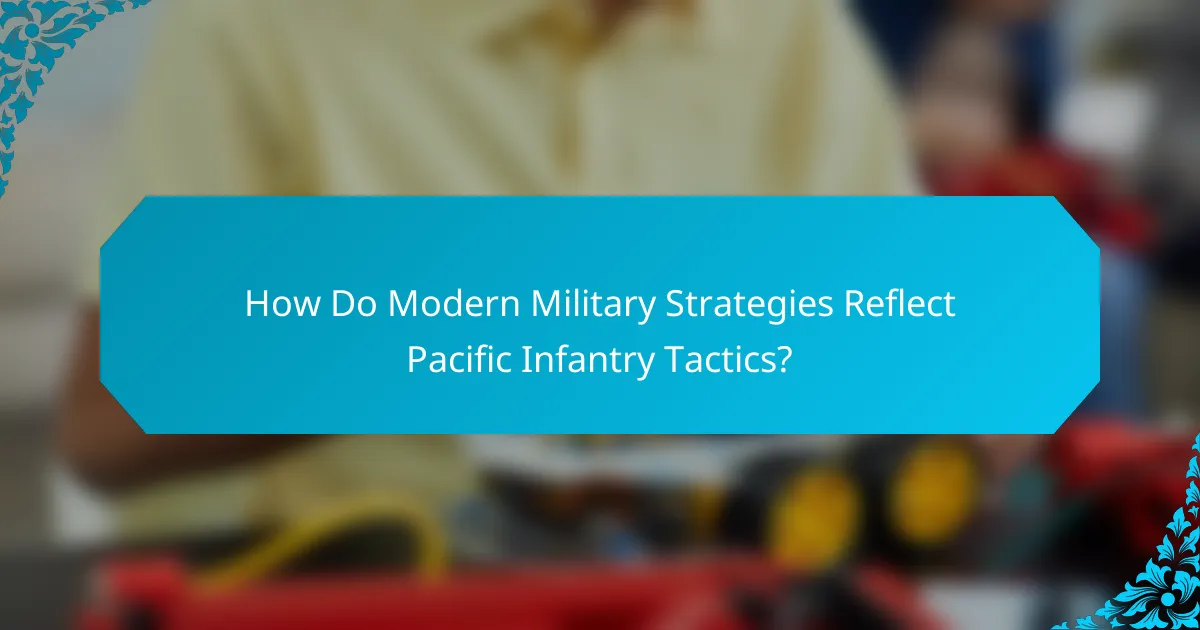
How Do Modern Military Strategies Reflect Pacific Infantry Tactics?
Modern military strategies incorporate lessons learned from Pacific infantry tactics by emphasizing adaptability, mobility, and the importance of terrain. These strategies focus on small unit operations, leveraging technology, and enhancing soldier training to respond effectively to diverse combat environments.
Current Jungle Warfare Training
Current jungle warfare training is designed to prepare infantry units for operations in dense, tropical environments similar to those encountered in the Pacific Theater. This training emphasizes skills such as navigation, camouflage, and survival techniques, which are critical for maintaining operational effectiveness in challenging terrains.
Soldiers undergo rigorous physical conditioning and tactical exercises that simulate real-world scenarios. Training often includes live-fire exercises, ambush tactics, and reconnaissance missions, allowing troops to practice their skills in a controlled yet realistic setting.
Effective jungle warfare training also incorporates lessons from past conflicts, focusing on the importance of teamwork and communication. Soldiers learn to work in small, cohesive units to enhance their ability to adapt quickly to changing situations and enemy tactics.
